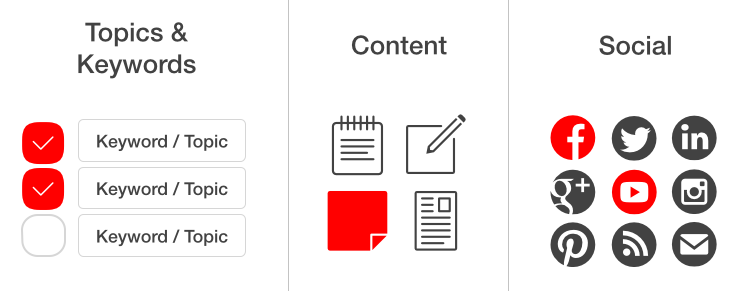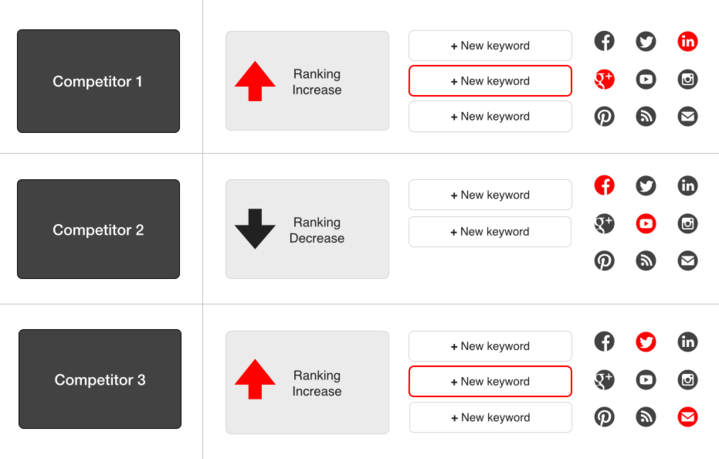When you think of brand competition what do you think of? Your mind probably goes straight to those brands your sales team tells you are going head to head with you for product features and services. I’ll bet you’re pretty good at keeping track of what those folks are doing, and you’ve created content that addresses your unique value proposition for your sales team to convince and convert prospects. Sound familiar?
What’s missing in that scenario is the ability to identify and discover your content competitors. In other words, all the content that may be taking traffic away from you and creating a barrier for audiences looking for information that will lead them to your product, service, or features. Now when you think of competitors, think of everyone, including those brands who may have peripheral products, but who are interfering with your message and then find a way to outrank them.
Content Competition Discovery
You know what marketers need more than anything else? Time. Am I right? When someone tells you all the things you need to do, in addition to what you’re already doing now, you’re probably wondering how you’re going to find the time. There are a few things you can do to make content competition discovery more time efficient and effective and still leave time to make your own content decisions based on the data you gather.

“Discovering new competitors is a little different for everyone in terms of what that exact mix will look like, but we created Competitor Discovery here a little over a year ago to automate the process and take the work out of the marketer’s hands,” notes Erin O’Brien, COO GinzaMetrics.
No matter what tool you use, employ these important tactics to improve your ability to discover and outrank content competitors:
- Create keyword groups
- Create content groups
- Segment content by medium, method, and message
- Monitor social signals
Before you get started, get a list of clearly defined keywords. Look beyond just the keywords that you’re already tracking. Get a list of all the keywords and topics relevant to your industry including those that are driving traffic to your content, those driving traffic to competitor content, and those that could be driving traffic to your site, but you aren’t using yet. Having a keyword discovery feature in your marketing intelligence platform will help discover those keywords you haven’t targeted yet.
Create Keyword Groups
Once you have a good list of keywords, create keyword groups. Create groups based on those things relevant to your brand and your marketing efforts. Keyword groups may include:
- Product features
- Product lines
- Persona types
- Trending topics
- Geographies
- Campaigns
“When creating keywords groups, keep in mind that keywords can belong to multiple groups. Keyword groups are one way to narrow down what you’re finding for the competition and will help you target your efforts to those things that actually matter to your brand,” states Erin.
The keyword groups you select will determine what type of competitor you monitor. Keyword groups that focus on product features and product lines will help you track those sales competitors, the ones you are probably already aware of, but may not be getting a complete picture of all the content they’re producing that competes directly with you. On the other hand, keyword groups that focus on persona types, topics, and campaigns may yield more industry-relevant publications and reveal some brands that you haven’t considered in the past.

Create Content Groups and Segment by Content Type
Creating content groups is much like creating keyword groups, except that you determine which content you have that fits into your pre-defined groups and then you track those URLs together.
When you’re grouping content, consider the types of content you already have and create groups based on the medium of the message. There can be a difference in how different mediums rank with your audience. Creating groups based on the medium will give you a way to filter out your results as well as get some insights into which mediums are working best for you. These might include:
- Video
- Slide deck
- Landing page
- Blog post
- Webinar
- Podcast
- EBook
- other
“The goal of content competitor discovery is to use the keywords and topics you’re already targeting and monitoring, and use them to discover any other content that is ranking highly for those keywords,” notes Erin.
Although there may be many brands that overlap you on a few keywords, those probably aren’t worth your time pursuing. Instead, set your sights on those brands with content that overlaps yours with at least a dozen of the same keywords.
Social Media Signals
Monitoring the social media platforms will help keep you up to date on what people are sharing and finding relevant in your industry. It may also give you a way to discover other players who are capturing audience attention that you haven’t identified yet.
Sharing content on social media channels is already an important factor for SEO. An active social media presence will continue to grow in importance as search engines rely on social sharing to help rank the relevancy of content in search results. Identify which social media channels are most used by your target audience and maintain an active presence there.
Outranking Content Competition
When you find new competitors to your content, what’s your first instinct? Did you immediately think, “Create new content!”? Although creating a lot of new content might be your natural tendency, there are some other things you can do that aren’t as time consuming and will get your content ranking faster. Of course, you might decide to create new content in addition to these suggestions:
- Perform a content refresh
- Include visual content
- Update/promote local reviews
- Re-promote on social media
Refresh Content
Before you start creating new content to outrank your content competition, take a look at what you already have. Ask yourself these questions:
- Do you have comparable content somewhere on the site already?
- Do we have something that addresses the topic, but uses outdated keywords?
- What relevant content be made more findable if its refreshed?
“Updating evergreen content is one of the biggest missed opportunities for brands,” according to Erin. “Over the course of time, people have created tons of content that’s not being leveraged because it just needs to be updated, or presented in a different way.”
Since you’re already grouping content by medium, why not look at one of your most popular mediums and refresh some website content in that medium. Say, for example, that you have an older blog post that covers a topic where a content competitor is beating you in the rankings. Refresh the content by re-writing it as a slide deck, or eBook, or create a video using the keywords your competitor is using to outrank you.
If you find a blog post that is still getting good engagement, or tackles a current topic, but isn’t getting attention because it doesn’t use updated keywords, you can simply update that blog. Capitalize on the relevancy of that blog by writing a follow-up piece and create links between the old blog and the new one.
Share visual content
If you’re trying to regain share of voice on a social media channel, consider creating content that lends itself to being shared. Since visual content is shared on social channels more than text-heavy content, create some visual content like videos, slide decks, infographics, or an image-heavy blog post. Why not create a visual case study or interview your customers for a video case study and create something that has inherent shareability?
Use local reviews to improve rank and trust
Local search results are a great place to look for reviews to use when you’re refreshing landing pages and your website. Consider turning these reviews, even if they’re old, into testimonials. You’ll improve your SEO for the keywords as well as gain credibility among your audience by letting others tell the story of how great your products are service are. If you’re able to, go back and ask someone who has posted a review to update their comments.

Re-promote on social media
Effective social sharing is not the same as automated social spraying. If you discover a topic that’s trending, or you’ve found some keywords you should be using, but haven’t, use your social media channels as a way to refresh your content. Re-sharing older posts with new tweets or tag lines can give it the little boost it needs to get in front of people and re-engage your audience.
“Here’s where setting up keyword and content groups in advance can really pay off,” notes Erin. “If you find a topic that’s getting a lot of play, look to your content groups for a source of content that’s already defined for that particular thing and start sharing that. You won’t have to look around and wonder if you have content, it’s already there.”
Staying Informed – Beyond Google Alerts
Google Alerts is a great tool to stay informed daily about what’s out there in your basic subject areas, topic areas, and to keep an eye on the competitors you know. However, tools like Google Alerts will not help you find content competitors who are creating content on their own sites.
A lot of what you’ll get on Google Alerts is news-related articles, press releases, and off-site content published on some of the industry publications. What you won’t get is an idea of how website published content, content shared on social media or via email, or existing content is changing your ranking and your competitor’s.
Getting the information you need to outrank your content competitors will take some effort up front to set up content and keyword groups and then effectively tracked them across the internet.
“That’s one of the reasons we created the Keyword Group and Content Group Wizards in GinzaMetrics, so you can do this really quickly and easily, as opposed to having to go in and manually create all of these groups. You just simply type in matching rules and we sort it for you. Even though it may not be the perfect end-result, it’s a first pass that takes a lot of the initial onus off you,” states Erin.

